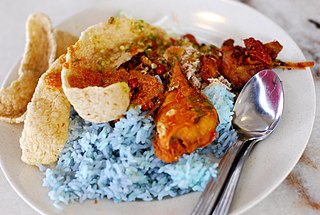
Malaysian cuisine consists of cooking traditions and practices found in Malaysia, and reflects the multi-ethnic makeup of its population. The vast majority of Malaysia's population can roughly be divided among three major ethnic groups: Malays, Chinese and Indians. The remainder consists of the indigenous peoples of Sabah and Sarawak in East Malaysia, the Orang Asli of Peninsular Malaysia, the Peranakan and Eurasian creole communities, as well as a significant number of foreign workers and expatriates.

Laksa is a spicy noodle soup popular in the Peranakan cuisine of Southeast Asia. Laksa consists of thick wheat noodles or rice vermicelli with chicken, prawn or fish, served in spicy soup based on either rich and spicy curry coconut milk or on sour asam. Laksa is commonly served in Indonesia, Malaysia, Singapore, and southern Thailand.

Malay cuisine is the cooking tradition of ethnic Malays of Southeast Asia, residing in modern-day Malaysia, Indonesia, Singapore, Brunei, Southern Thailand and the Philippines as well as in Cocos Islands, Sri Lanka and South Africa. Different Malay regions are all known for their unique or signature dishes—Pattani, Terengganu and Kelantan for their nasi dagang, nasi kerabu and keropok lekor; Pahang and Perak for its durian-based cuisine, gulai tempoyak; Kedah and Penang for their northern-style asam laksa and rojak; Satun and Perlis for its bunga kuda dessert; Negeri Sembilan for its lemak-based dishes; Malacca for their spicy cincalok; Singapore for their rojak bandung and roti prata; Riau for its ikan patin dishes, gulai ikan patin and asam pedas ikan patin; the Riau Islands for their sup ikan; West Sumatra for its rendang and lemang; Deli Malays of North Sumatra for their nasi goreng teri medan and gulai ketam; Jambi for its ikan mas panggang and tempoyak; Palembangese Malays of South Sumatra for their pempek, mi celor and nasi minyak; Bangka Belitung for its siput gonggong and terang bulan; West Kalimantan and Sarawak for its bubur pedas and ayam pansuh; Brunei for their nasi katok and unique ambuyat dish; Sri Lankan Malays of Sri Lanka for its kalu dodol and watalappam; and Cape Malays of South Africa for their bobotie, boeber and koe'sister.
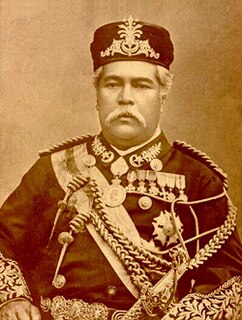
Sultan Sir Abu Bakar ibni Almarhum Temenggong Seri Maharaja Tun Daeng Ibrahim was the Temenggong of Johor. He was the 1st Sultan of Modern Johor, the 21st Sultan of Johor and the first Maharaja of Johor from the House of Temenggong. He was also informally known as "The Father of Modern Johor", as many historians accredited Johor's development in the 19th century to Abu Bakar's leadership. He initiated policies and provided aids to ethnic Chinese entrepreneurs to stimulate the development of the state's agricultural economy which was founded by Chinese migrants from Southern China in the 1840s. He also took charge of the development of Johor's infrastructure, administrative system, military and civil service, all of which were modelled closely along Western lines.

Hokkien mee is a Southeast Asian dish that has its origins in the cuisine of China's Fujian (Hokkien) province. There are three distinct types of Hokkien mee found in Malaysia and Singapore.

Otak-otak, which literally translates as "brains" in Indonesian and Malay languages, is a Southeast Asian fish cake made of ground fish meat mixed with spices and wrapped into leaf parcels. Otak-otak is traditionally served fresh, encased within the leaf parcel it is cooked in, and can be eaten solely as a snack or with steamed rice as part of a meal.

Rice vermicelli are a thin form of rice noodles. They are sometimes referred to as rice noodles or rice sticks, but they should not be confused with cellophane noodles, a different Asian type of vermicelli made from mung bean starch or rice starch rather than rice grains itself.

Peranakan cuisine or Nyonya cuisine comes from the Peranakans, descendants of early Chinese migrants who settled in Penang, Malacca, Singapore and Indonesia, inter-marrying with local Malays. In Baba Malay, a female Peranakan is known as a nonya, and a male Peranakan is known as a baba. The cuisine combines Chinese, Malay, Javanese and other influences.
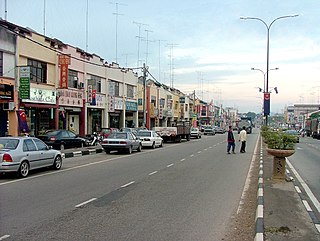
Yong Peng is a town in Mukim Tanjung Semberong, Batu Pahat District, Johor, Malaysia. It has an area of 1911.6 hectares with an estimated population of 29,046.

Mie kuah, literally "noodle soup", or also known as mie rebus/mi rebus or mee rebus, literally "boiled noodles", is a Malay archipelago noodle soup dish, and popular in Maritime Southeast Asia countries such as Malaysia, and Singapore.
Johor State Constitution is the state constitution of Johor, promulgated on 14 April 1895 by Sultan Abu Bakar. The contents of the constitution covers many aspects:
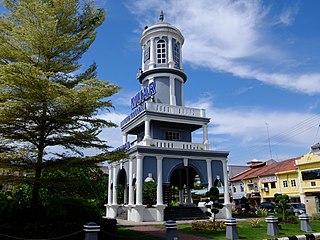
Muar or Bandar Maharani, is a historical town and the capital of Muar District, Johor, Malaysia. It is one of the most popular tourist attractions in Malaysia to be visited and explored for its food, coffee and historical prewar buildings. It was recently declared as the royal town of Johor by Sultan Ibrahim Sultan Iskandar and is the fourth largest city in Johor. It is the main and biggest town of the bigger entity region or area of the same name, Muar which is sub-divided into the Muar district and the new Tangkak district, which was upgraded into a full-fledged district from the Tangkak sub-district earlier. Muar district as the only district covering the whole area formerly borders Malacca in the northern part. Upon the upgrading of Tangkak district, the Muar district now covers only the area south of Sungai Muar, whilst the northern area beyond the river is in within Tangkak district. However, both divided administrative districts are still collectively and fondly called and referred to as the region or area of Muar as a whole by their residents and outsiders. Currently, the new township of Muar is located in the Bakri area.
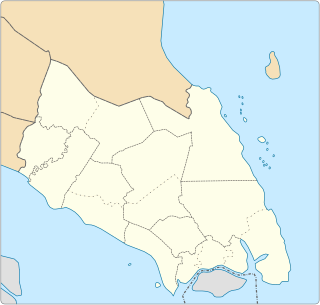
Batu Pahat (BP) is a city and capital of Batu Pahat District, Johor, Malaysia. It lies south-east of Muar, south-west of Kluang, north-west of Pontian and south of Segamat. The town area is located inside Simpang Kanan parishes.

Rojak or rujak is a salad dish of Javanese origin, commonly found in Indonesia, Malaysia and Singapore. The most popular variant in all three countries is a salad composed of a mixture of sliced fruit and vegetables served with a spicy palm sugar dressing. It is often described as tangy and spicy fruit salad due to its sweet, hot and spicy dressing made from ground chilli, palm sugar and peanuts.

Mie jawa, also called as mi jawa or bakmi jawa in Indonesia, or mee Jawa in Malaysia is a traditional Indonesian–Javanese style noodle, commonly found in Indonesia and Malaysia. The dish is made of yellow noodle, chicken, vegetables, egg and spices. The recipe however, is slightly different between mie jawa in Indonesia and mee Jawa in Malaysia.
Sulaiman bin Ninam Shah was a Malaysian businessman and veteran politician. He was also former member of Johore State Council for Muar Coastal (1954–1959) and Johor State Legislative Assembly for Parit Jawa (1959-1964), former Senator (1979-1985) and the 6th Deputy President of the Dewan Negara (1982-1985). He is one of the founders of United Malays National Organisation (UMNO) and former Permanent Chairman of UMNO (1976-2003).
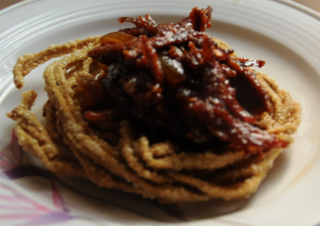
Mee Siput Muar is a famous local snack which originated from and is most available in Muar, Johor, Malaysia. The snack got its name as in the old days it was traditionally hand-made of wheat flour dough that will be shaped into noodle thread and swirled in circular pattern to resemble like the shell of siput, or snail in Malay. And beside its shape, the crispy texture of the so called snail noodle cracker is also similar to the fragile condition of the snail shell. It was then dried in the sun before deep-fried in cooking oil until crispy and crunchy. The ready to beaten snack is best served with condiments like sambal; chili paste or soya sauce.
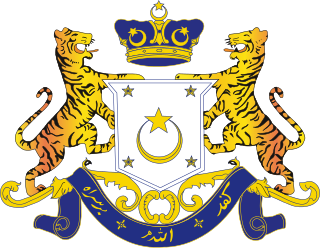
Che' Puan Besar Khaleeda binti Bustamam is the wife of Tunku Ismail Idris. Through her marriage she is the Consort of the Crown Prince of the Malaysian State of Johor.
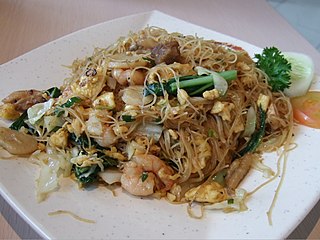
Bihun goreng, bee hoon goreng or mee hoon goreng refers to a dish of fried noodles cooked with rice vermicelli in both the Indonesian and Malay languages. In certain countries, such as Singapore, the term goreng is occasionally substituted with its English equivalent for the name of the dish.






















